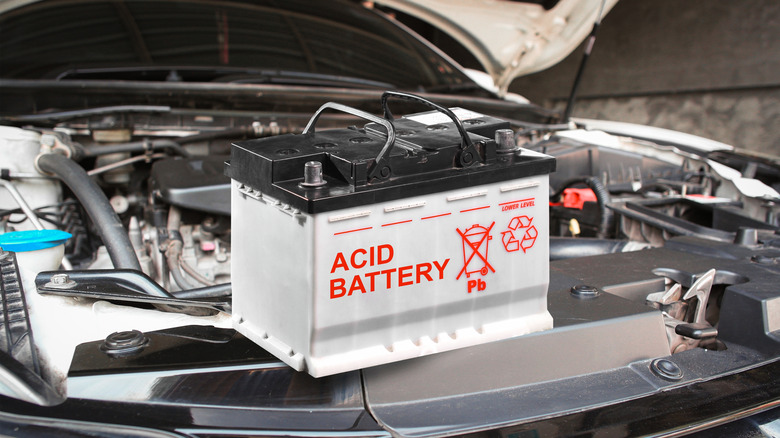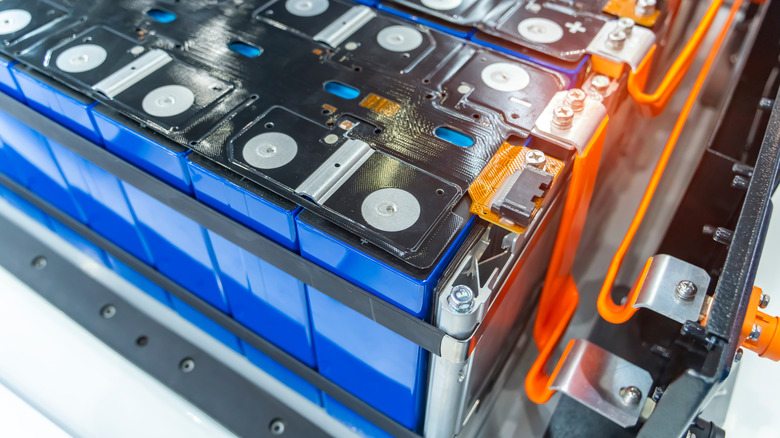What's The Difference Between Electric Batteries Vs Regular Batteries For Cars?
There are two main types of cars on the road: Electric vehicles (EVs) and the classic "regular" vehicles that are powered by internal combustion engines (ICE). They're similar in some ways and drastically different in others. For instance, EVs are often more expensive to buy new, and charging stations are less abundant than traditional gas stations. However, there are a lot of things that EVs do better than ICE vehicles, and their batteries are a great example of that.
Just like the two types of vehicles themselves, their batteries share some similarities. Both types ultimately serve the same purpose by storing electrical energy. EV batteries are charged from external sources, like a charging station or a home charger. ICE car batteries (which are almost always lead–acid) are continuously charged by their car's alternator, which converts some of the energy generated by the engine into electricity. But once juiced up, both types perform their duty to make sure a car's electrical system can operate untethered to the grid. And that's basically where the similarities between the two batteries end and the differences start to emerge.
From an engineering and scientific perspective, EV and ICE batteries might as well be from different planets. One is the volume of a twin-sized mattress, half a ton in weight, wildly expensive, composed of hundreds of cells, and built with an array of rare precious metals. The other is a regular old lead–acid battery. The best way to highlight the stark differences between EV and ICE batteries is to consider them through three lenses: their chemical makeup, their dimensional differences, and their energy capacities.
Differences in chemistry: lead versus lithium
Batteries were first used in internal combustion engine cars over 100 years ago, and their design hasn't changed much since. They're reliable, rechargeable, and cheap to make. And, unlike EV batteries, standard car batteries contain essentially no precious metals. In a standard car battery, you'll find lead dioxide, lead sulfate, sulfuric acid, and pure lead in its metallic form. The electrodes are also mostly made of lead oxides, though they often contain small amounts of tin, antimony, and calcium as well. The rest of the battery is typically constructed out of plastic.
EV batteries aren't nearly as antiquated — nor as cheap. Instead of lead-based acids to store the charge, EV batteries almost universally employ lithium-ion solutions. Thanks to their light weight and high capacity, lithium batteries are also the preferred choice in smartphones, tablets, and laptops. Standard car batteries are much heavier by volume, but they can get away with it since they are so much smaller in size.
Besides lithium, there are other chemicals present in EV batteries that are absent in standard car batteries. These include manganese, cobalt, nickel, and carbon compounds, such as steel and graphite. Though not scientifically classified as rare earth metals, many of the chemicals in EV batteries are still rare. That's why used EV batteries often get recycled for their valuable materials.
Even though standard lead–acid batteries contain no highly valuable elements, they're still extensively recycled around the world. In fact, 99% of spent lead–acid batteries are recycled for their lead. The recycled materials can be extracted for reuse relatively easily and cheaply, though at a human cost. Lead–acid battery recycling is a health hazard and a massive source of pollution, so the environmental benefits are quickly offset.
Differences in dimensions: Toaster-sized versus mattress-sized
There's a reason a standard lead–acid battery is so small while an EV battery is so big. The former only needs to have enough energy to power the car's electronics and ignition, and it also gets continuously recharged as long as the engine is running. The latter is responsible for a lot more. An EV battery must store enough electricity to accelerate the entire vehicle for hours on end, and it doesn't get continuously recharged.
The battery in an EV tacks on thousands of additional pounds in weight, requiring more energy to accelerate compared to their ICE counterparts. Your standard lead–acid car battery weighs roughly 30 to 50 pounds. EV batteries, on the other hand, can weigh between 1,000 and 2,000 pounds. Should the world ever run out of lithium, we may switch to new battery designs that weigh less. For now, EVs weigh a ton.
The resulting size difference tells a big part of the story. Most of us are familiar with the sight of the toaster-sized batteries found under the hoods of standard ICE cars, but few of us have actually laid eyes on an EV battery. That's because EV batteries are hidden from view. They're usually placed in the floor of the vehicle, which helps with weight dispersion and space efficiency.
Electric vehicles have to save space, too, because the physical size of their batteries is massive. Comprised of hundreds of cells placed in bundled packs, EV batteries reach tens of thousands of cubic inches of volume. For example, a 40 kWh (kilowatt hour) Nissan Leaf battery has dimensions of approximately 62 × 47 × 10.5 inches, which translates to nearly 30,000 cubic inches. That's roughly the size of a twin-size mattress — compare that to the toaster-sized battery in an ICE sedan.
Differences in capacity: Moving a car versus turning on the radio
While EV batteries are bigger than ICE batteries, they're much more efficient in a couple of different ways. For one, the lithium-ion batteries in EVs have a higher energy density than their lead–acid cousins. That means they can store more energy per unit of volume. The specifics vary depending on the battery in question. On average, a lithium-ion battery has an energy density of about 150 to 250 Wh/kg (watt hours per kilogram), while a lead-acid battery can only store about 30 to 40 Wh/kg.
EV batteries also have a lower mass density, meaning they weigh less per unit of volume. It makes sense, since lithium is less dense than lead. Consequently, the density of an EV's lithium-ion solution is less than half that of the lead-acid solution used in ICE batteries. With a higher energy density and lower mass density, EV batteries are more energy efficient and more space efficient.
For perspective, consider the average energy stored by an EV compared to that of an ICE battery. Depending on the model of car, a typical electric vehicle has a capacity between around 75 kWh and 135 kWh, with some larger vehicles, such as electric trucks, reaching 200 kWh and beyond. That's enough energy for a single charge to provide a driving range of about 200 miles. Regular ICE batteries, on the other hand, store far less. They're usually 12-volt batteries with an average capacity of about 48 amp hours. That translates to just less than 0.6 kWh. So, you would need over 160 lead-acid batteries to store the same amount of energy as a fully charged 100 kWh EV battery.



